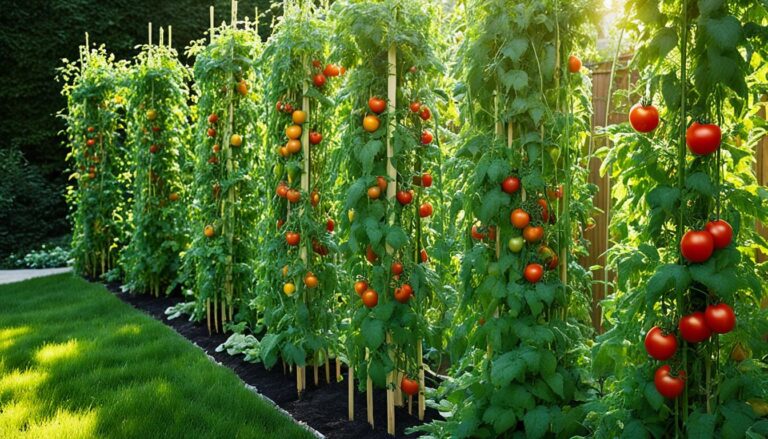In This Article
Key Takeaways
- Staking and trellising tomato plants improves air circulation, prevents disease, and makes harvesting easier.
- Determinate tomatoes are well-suited for cages, while indeterminate plants thrive with staking or trellising.
- Staking takes up less space than caging, but requires careful tying to avoid damaging the plants.
- A string trellis system provides a versatile, easy-to-implement support structure for both plant types.
- Proper maintenance through pruning and training is essential for healthy, productive tomato plants.
How to stake and trellis tomato plants?
Did you know that 97% of experienced gardeners swear by staking or trellising their tomato plants to achieve bountiful harvests?1
Proper support systems matter, whether you’re growing in pots or in rows. This guide covers the benefits of staking and trellising. It also talks about the different types of tomatoes and how to cage, stake, or use a string trellis. By the end, you’ll know the best way to support your tomato plants.1
Introduction to Staking and Trellising Tomato Plants
Benefits of Staking and Trellising Tomatoes
Staking and trellising have many advantages. They keep plants tidy and save space, which reduces the risk of disease.1 Plus, it keeps fruits off the ground, making them less accessible to pests.1 Picking and pruning are also easier with a good staking system.1
Types of Tomato Plants: Determinate vs. Indeterminate
Tomatoes come in two types – determinate and indeterminate. Determinate tomatoes are smaller and bear all their fruit in two weeks. They need less staking.1 Indeterminate tomatoes are larger, bear fruit over a longer time, and produce more.1 They need strong support from staking or trellising.1
Introduction to Staking and Trellising Tomato Plants
Benefits of Staking and Trellising Tomatoes
Staking and trellising tomato plants has many upsides. It makes the garden neater and saves space. This helps in lowering the chance of fruit spoilage and diseases.2
Fruits stay off the soil thanks to staking. It also keeps bugs away and makes the plants easy to trim and pick.2
Types of Tomato Plants: Determinate vs. Indeterminate
Tomatoes come in two types – determinate and indeterminate. Determinate tomatoes hit a set size and give all their fruits quickly. They need less support for staking.2
Indeterminate tomatoes grow big, give lots of fruits over time, and need more staking help.2
Staking and Trellising
Caging Tomatoes
Determinate tomato plants need a cage for support as they grow. These cages are put around the plant early. As the tomato grows, it fills the cage. This method keeps the plant from falling over. It works for both determinate and indeterminate tomatoes. However, indeterminates might need bigger cages because they grow taller.3
Staking Tomatoes
Using stakes is another way to support tomato plants. It’s a simple and cost-effective method. Each tomato plant gets its own stake. You just tie the plant to the stake as it grows. This keeps the plant upright and stops it from sprawling. Stakes can be made from wood, plastic, steel, or bamboo. They should be strong enough to hold up the plants.3
Staking Methods: Florida Weave, Single Stake, Double Stake
There are different ways to stake tomatoes. The Florida weave, single stake, and double stake are popular. In the Florida weave, plants are set in two rows. Stakes are put at the ends and in between. Then, twine is tied to support the plants. Each plant stands alone with the single stake method. Double staking uses two stakes and twine. This helps very large, heavy tomatoes from falling.3
Materials and Setup for String Trellis System
Creating a Support Structure
An amazing garden idea is the string trellis. You start by placing sturdy T-posts every 6-8 feet.4 Run a strong bar, like a wood beam, between these posts.4 This bar will hold all the strings.
Setting Up the String Trellis
After the frame is ready, add thick strings every foot or so along the bar.4 Make sure to secure the strings at the bottom. This could be done with garden staples or by tying them to the plant.4 Now you have a string network for your tomatoes to climb.
Planting and Training Tomatoes on String Trellis
Plant tomato seedlings just in front of each string, leaving 12-18 inches in between.4 As they grow, start to gently wrap their main stems around the string.4 Keep winding as the plants get taller. Also, cut off any leaves the plant doesn’t need. This helps them grow up the strings better.
Pruning and Maintenance
Taking care of tomato plants includes cutting off suckers. Suckers are small shoots between the main stem and leaves. When you remove them, the plant can put more energy into making tomatoes. Plus, cutting off suckers helps air move around the plant better.5
Continue to gently wind the main stem around the strings as tomato plants get taller on the trellis. Add more support like new strings or bungee cords when needed. This weekly task keeps the tomato plant climbing straight up.
Removing Suckers and Excess Foliage
Continuing to Wind and Train Tomato Plants
Staking and Trellising
Benefits of Staking and Trellising
Staking and trellising tomato plants do a lot of good. They stop diseases by letting air flow around the plants.3 This keeps fruit off the ground, so it’s less likely to rot or be eaten by pests.6 Plus, it’s easier to prune, take care of, and pick the tomatoes if they’re supported.3 These support methods mean you can have more tomato plants in a small garden.6
Choosing the Right Method for Your Garden
In choosing how to hold up your tomato plants, think about what tomato kind you have and your garden’s size. Consider your own likes too.3 If you’re growing short tomatoes, using a cage is best. For the taller ones, use stakes or a trellis.3 A string trellis is great for any kind and various garden sizes.7 Pick the best support by thinking about what you need and the space you have.
Conclusion
Staking and trellising tomato plants is key for garden success. It gives plants support, raising their yield and reducing disease risk. You can use cages, stakes, or string trellises, just pick what suits your space and tomato type.
Correctly setting up these supports and caring for your plants leads to lots of tasty tomatoes at harvest time. This guide shares tips to help you grow your best crop.8
There are many good things about staking and trellising, like more tomatoes and less disease. Take time to learn the best way for your garden. Then, watch your tomatoes do well and give you plenty of great fruit. With the best support, you’re set for a great tomato-growing season.
FAQ about Staking And Trellising Tomato Plants
What are the benefits of staking and trellising tomato plants?
Staking or trellising tomato plants has many benefits, like saving space. It keeps plants organized. This helps reduce the risk of diseases and pests.
It also makes it easier to pick and trim the tomatoes. And it prevents the fruits from touching the ground.
What are the different types of tomato plants?
Determinate and indeterminate are the two main types of tomato plants. Determinate kinds grow up to a certain size and produce fruit in a 2-week window. Indeterminate tomatoes keep growing and producing more tomatoes.
Indeterminate tomatoes also have a longer fruiting period. This makes them great for continuous harvests.
What are the different staking and trellising methods for tomato plants?
The different methods include:
- Tomato cages – for determinate types
- Individual staking with wooden or bamboo stakes
- Florida weave and various staking methods
- String trellis system
Each method has its benefits. For example, tomato cages are good for determinate plants. The string trellis, on the other hand, is versatile and fits many tomato types.
How do you set up a string trellis system for tomato plants?
Here’s how to set up a string trellis system:
- Install strong posts 6-8 feet apart
- Put a bar across the posts at the top
- Hang thick strings every 12-18 inches
- Secure the strings to the ground or around the plants
- Plant the tomatoes 12-18 inches from the strings
The system allows tomatoes to grow up the strings. This saves space and keeps fruits off the ground.
How do you maintain tomato plants that are staked or trellised?
To care for your trellised tomatoes, do these things:
- Prune any suckers that grow
- Guide the main stem up the strings or stakes
- Add more support like strings as the plants grow
By doing this, your plants stay healthy and produce more.
How do I choose the right staking or trellising method for my tomato plants?
When picking a method, think about your tomatoes and garden. Consider your likes, too. Determinate tomatoes are good with cages. For larger plants, use stakes or trellises. A string system is good for both types.
Source Links
- https://anoregoncottage.com/shl-ep-3-trellising-tomatoes/
- https://journeywithjill.net/gardening/2018/04/10/tomato-trellising-deciding-which-method-is-right-for-you/
- https://www.allthatgrows.in/blogs/posts/trellis-stake-garden-plant-supports
- https://www.johnnyseeds.com/growers-library/methods-tools-supplies/pruning-trellising/trellising-tomatoes.html
- https://extension.usu.edu/yardandgarden/research/grape-trellising-training-basics
- http://www.hybridveggies.com/2017/06/effective-ways-of-staking-and.html
- https://sites.lafayette.edu/lafarmblog/2015/07/01/staking-and-trellising-tomatoes/
- https://extension.uga.edu/publications/detail.html?number=C1150&title=staking-and-pruning-tomatoes-in-the-home-garden

